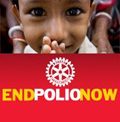 This is the conventional wisdom, often presumed to have been settled long ago and to be effectively beyond question.
This is the conventional wisdom, often presumed to have been settled long ago and to be effectively beyond question.
But historian Dr William Muraskin from the City University of New York has just published a provocative new book which asks whether mobilising the global health community in the fight against polio is the best use of scarce resources. It has raised plenty of eyebrows but also some valid questions about the future direction of immunisation and development policy.
- Experts believe polio is close to being eradicated, banished from 99% of the World’s population
- Eradication effort has taken longer and been more expensive than expected
- New book claims a small number of experts hijacked WHO agenda in 1980s to change global health priority from primary healthcare to ‘the more glamorous goal’ of eradication
- After polio: Debate on whether to pursue new eradication campaigns or switch back to building primary health systems and routine immunisation programmes
Muraskin’s contention, in short, is that fighting polio has cost billions of dollars more than expected, taken far longer than ever anticipated, and diverted attention from less glamorous efforts to build primary health infrastructure and establish routine immunisation programmes in the world’s poorest countries.
Opportunity costs
In a keynote address at a conference on vaccine decision-making, hosted by the , Muraskin charted the history of how polio eradication reached the top of the global health agenda.
He claimed that in the wake of smallpox eradication, a small number of eradication enthusiasts went in search of a disease to wipe out and they eventually settled on polio.
As Muraskin tells it, in the early 1980s the WHO was embracing primary healthcare and there was initially limited enthusiasm among experts for the eradication. But by 1988 the World Health Assembly – the WHO’s main decision-making body – had committed to ending polio by the end of 20th century.
In a thought-provoking and often contrarian address, Muraskin claimed that politicians and philanthropists find eradication campaigns much easier to support than low-profile long-term health system development work. “Nobody ever erects a statue for those who build primary care systems,” he told Vaccines Today.
Not only is this glamour helping to sustain momentum in today’s polio eradication campaign, according to Muraskin, it has already prompted talk of how to harness the anti-polio infrastructure to eradicate other preventable illnesses.
Final push
While the polio eradication drive has proven much more complex than earlier hoped, international public health experts at the WHO believe the end is in sight, with the disease banished from 99% of the world’s population. This leaves just a few corners of Pakistan, Afghanistan and Nigeria where the polio is still stubbornly endemic.
Non-governmental organisations like The Gates Foundation and Rotary Club have also injected huge levels of energy – and funding – in pursuit of what they see as the ultimate goal. Like the last mile of a marathon, say eradication advocates, the final push can be the toughest but the most rewarding.
Muraskin’s almost heretical challenge to eradication orthodoxy sparked considerable debate and some pushback from those devoted to ending polio. While most agreed that the consensus should always be subject to continuous challenge, there was some unease about the release of a book on the history of polio eradication before the job is done.
The standard response to criticism of the costs of eradication programmes is that if the disease is wiped out the benefits are infinite: not only will the pain and death caused by polio be consigned to history books, but nobody will ever again need to be vaccinated. By that logic, there is essentially no limit to how much should be spent in pursuit of eradication. It is also strongly argued that the money flowing into polio eradication – from the Gates Foundation and Rotary International, for example – is not money that would otehrwise have been spent on health at all.
Yet concerns about the unintended consequences of an aggressive anti-polio push and lingering doubts about whether it will really be possible to achieve eradication are fraying nerves in some quarters.
Official history
Dr Roland Sutter, a WHO expert who has worked to defeat polio for more than two decades, offered a less dramatic history of how polio eradication became the shared goal of the public health community.
He charted the progress that began with the licensing of the inactivated polio vaccine in the US in 1955 and the landmark decision by the World Health Assembly 33 years later, to the success of cutting reported polio cases by 99% by 2000 and the ongoing technical challenges of finishing the job.
Sutter told Vaccines Today how officials had to fight to keep the polio eradication programme alive in the early part of the 21st century but he said enthusiasm – and optimism – has since returned. “Over the past three years there had been a lot more energy in the project,” he said, lauding the commitment of philanthropists and charities criticised by Muraskin.
Current challenges to wiping out polio include vaccine-derived poliovirus which has led to outbreaks over the past decade, according to Sutter.
Top-down health policy?
Dr Philippe Duclos, of the WHO’s ‘SAGE’ expert committee which advises on immunisation, took issue with Muraskin’s suggestion that the WHO imposes its policies on poor countries without adequate consultation. Muraskin had claimed that polio eradication was a concept pushed in the 1980s primarily by US officials, and that developing countries had never identified polio as their public health priority.
“The WHO does not put pressure on countries. SAGE offers advice only from its 15 members each of whom serves in their individual capacities,” Duclos said. Advice is based on disease epidemiology, clinical characteristics, availability of vaccines and economic considerations, he added.
Now what?
Despite the debate stirred by Muraskin’s new book, many in the public health community will hope it is too late to derail the (perhaps) imminent success of the polio eradication campaign.
The big question is: what next? If polio can be wiped out, what will have been learned?
The early rumblings of a debate about eradication versus primary healthcare are already audible but it is far from clear which way the pendulum will swing?
Should the next step be to repurpose the highly-tuned eradication ‘machine’ to rid the world forever of other vaccine-preventable diseases or is it wiser to invest in delivering healthcare and routine immunisation to those who need it most?
What do you think?




